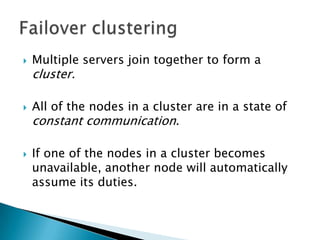Sql serverŌĆÖs high availability technologies
- 1. SQL ServerŌĆÖs High Availability Technologies
- 2. TechnologiesWindows failover clustering provides protections against server failure.Database mirroring and log shipping provide protection against site and database failure.Peer-to-peer replication can provide protection against site and system failure.Database snapshots provide protection against database corruption.Fast recovery reduces the time required to recover a database from a backup.
- 3. Failover clustering OverviewServer-level protection from both unplanned and planned downtime.
- 4. Failover clusteringMultiple servers join together to form a cluster.All of the nodes in a cluster are in a state of constant communication.If one of the nodes in a cluster becomes unavailable, another node will automatically assume its duties.
- 5. Database MirroringDatabase mirroring provides database-level protection from unplanned downtime
- 6. Database MirroringChanges in the principal database are sent to a backup database called the mirrored database.If the principal fails, the mirrored database on a different SQL instance will be instantly available.Just protects user databases.The transaction log is monitored for changes to the principal database.changes are then copied out of the transaction log of the principal server and sent over the network to the mirror server.
- 7. Log ShippingAn inexpensive protection against server failure.
- 8. Log ShippingTransaction log backups are periodically sent from the primary serverŌĆÖs database and applied to the database on the backup server.Log shipping can send the captured transaction logs to multiple destinations.All recovery for log shipping is manual. There is no automatic failover.
- 9. Designed for bidirectional replication and high availability scenariosDatabase changes can be made to any of the peer nodes, and each node publishes the updates to the other peer nodes.Peer-to-Peer Replication
- 10. Peer servers are continually available.Can be used by applications or used as distributed reporting servers.Does not offer any automatic failoverPeer-to-Peer Replication
- 11. Enable databases to recover more quickly from unplanned downtime.As changes are made to the database, the changed pages are copied into the snapshotRestore the database by copying to it the original pages saved in the snapshot.Database Snapshots
- 12. Backup and restore process allows an entire database to be recovered to any given point in time.Full backup A full database backup is a complete copy of the database. Differential backup A differential backup copies only the database pages modified after the last full database backup.Transaction log backup The transaction log backup copies the changes that have occurred since the last full or differential backup. Transaction log backups may be applied after the last full or differential backup has been restored.Backup and Restore
- 13. Summary of SQL Server 2008ŌĆÖs High Availability Options
- 14. Proposed Design














